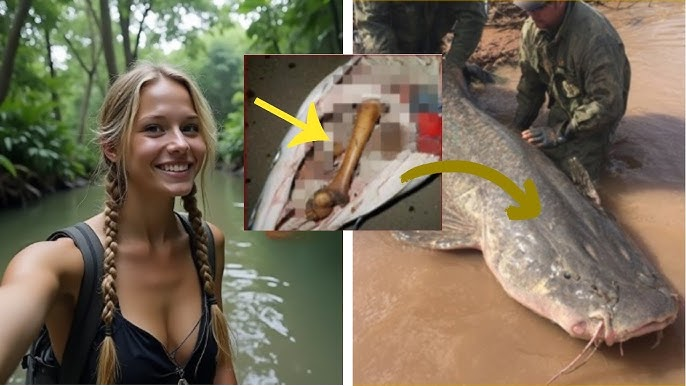
In the dense, humid heart of South Carolina’s Congaree National Park, where ancient cypress trees tower like silent guardians over swampy floodplains, a young woman’s routine hike turned into one of the most bizarre mysteries in modern criminal history. Lauren Mills, a 26-year-old graduate student in biology at the College of Charleston, set out on a sunny July morning in 2004 for what should have been a straightforward day of research. She never came back. Five years later, in a twist that defies belief, her remains were discovered not buried in the earth or lost in the underbrush, but inside the stomach of a massive flathead catfish caught by a local fisherman. This discovery didn’t just close a chapter on her disappearance—it opened a Pandora’s box of questions about accident, foul play, and the unforgiving power of nature.
Lauren’s story starts like so many tales of adventure gone wrong. On Saturday, July 17, 2004, she left her apartment on King Street in Charleston around 7:30 a.m., buzzing with excitement. As a specialist in old-growth floodplain forest ecosystems, Congaree National Park was a goldmine for her dissertation work. The park, about 100 miles northwest of the city, boasts some of the tallest trees in the eastern U.S. and a labyrinth of creeks feeding into the Congaree River. Lauren planned a solo trek along the Weston Lake Loop Trail, a 4.5-mile circuit that promised plant samples, photos, and a quick return before dark. She packed light: a one-liter water bottle, energy bars, a camera, notebook, sample bags, and her car keys. Dressed in dark hiking pants, high-top boots, and a bright red windbreaker, she drove her reliable 1988 blue Honda Civic to the Harry Hampton Visitor Center, parking it neatly by 9:15 a.m.
Her roommate, Jessica Riley, 25 at the time, remembered Lauren’s good spirits that morning. They chatted about the plan—hike out, collect data, back by 6 p.m. No cell phone, since coverage was spotty in the park. It was midsummer in South Carolina: temperatures pushing 95 degrees Fahrenheit, humidity thick as fog, with thunderstorm warnings. Lauren was no novice; she’d hiked similar terrains before, knew the risks of alligators, wild boars, and venomous snakes. Friends and family trusted her judgment. But as evening fell, worry set in.
By 9 p.m., Jessica grew uneasy. Calls to mutual friends turned up nothing. Lauren’s phone, left behind, rang uselessly in the apartment. At 11 p.m., Jessica alerted authorities. The Charleston Police handed it off to Richland County Sheriff’s Office and the National Park Service, given the park’s jurisdiction. Deputy Mark Jenkins arrived at the visitor center around 3 a.m. on July 18, spotting Lauren’s locked Honda with a park map on the seat—no signs of struggle.
What followed was a massive search operation. At dawn, a command center sprang up. Teams from the Park Service, sheriff’s office, and state emergency services combed the trail and a 500-meter radius. Conditions were brutal: post-storm mud, thick undergrowth, 100% humidity. By day’s end, nothing. K-9 units joined on July 19, but scents crossed with wildlife trails. Water teams scoured Cedar Creek and the Congaree River’s shores in boats and kayaks. Helicopters buzzed overhead, but the canopy hid everything. After four days and over 100 searchers covering dozens of square kilometers, the effort wound down on July 21. No clothing scraps, no backpack, no traces.
The case shifted to criminal investigation on July 24, assigned to Detective Robert Peterson. Scenarios abounded: a fall and injury, snake bite, alligator attack, drowning. But no evidence supported any. Violent crime? Visitor logs showed no suspicious activity; no one recalled a girl in a red jacket. Lauren’s life was squeaky clean—no enemies, no debts, no shady ties. Her computer and belongings revealed no plans to flee. The family hired a private detective and organized volunteer searches, but zilch. By December 2004, it was a cold case, archived and forgotten by most.
Years ticked by. The Mills family ran annual ads with Lauren’s photo, pleading for tips. Nothing. Congaree hummed on, its river flowing lazily, home to hefty flathead catfish that could top 100 pounds. Then, on August 12, 2009, retiree Douglas Harris, 58, from nearby Gadsden, launched his boat for a catfish hunt. He motored to “Catfish Hole,” a deep pool south of the trail, baited with fresh bream. Around 4 p.m., a monster struck. After a 30-minute battle, he hauled in a 110-pound behemoth, nearly five feet long. Thrilled, he took it home to process with his wife, Mary.

In their backyard that evening, Mary gutted the fish. Amid half-digested fish and debris, she spotted bright red fabric—synthetic, like a windbreaker. Then dark blue nylon, perhaps from a backpack. A long bone emerged, unmistakably human—a femur. Rubber sole fragments with laces followed, and finally, three keys on a ring, one for an old Honda. Horrified, Douglas called the sheriff at 7:43 p.m. Deputies arrived, confirmed the finds, and linked it to Lauren’s case via the database.
The catfish’s stomach contents went to Chief Medical Examiner Dr. Alistair Finch. Cataloged: right femur, three thoracic vertebrae, pelvic fragment, two ribs. Plus red fabric (20×15 cm), blue nylon with buckle, boot sole, Honda keys. Bones indicated a female, 25-30 years old. One rib showed a healed fracture—smooth, from a blunt force blow, not a fall. DNA from the femur matched Lauren’s family sample at 99.9%. She was declared dead on August 15, 2009.
The theory: Lauren’s body sank in the river, decomposition slowed by low oxygen. The scavenger catfish ingested soft tissues, bones, and items over time. But the rib fracture? It suggested violence, challenging the accident narrative.
The sheriff announced the find on August 19, sparking media frenzy—”Girl in the Catfish.” Peterson, now captain, reopened the case. Re-interviews yielded faded memories. Two theories: Accident—slip, hit rib on snag, drown. Or murder—assailant strikes, dumps body. Geography supported both; databases showed no linked crimes. Public appeals flopped. By early 2010, investigation suspended. Coroner ruled “probable drowning” under “unexplained circumstances.”
The family rejected accident, citing Lauren’s caution and the rib as proof of foul play. They cremated remains, held a service, and withdrew from media, convinced a killer walked free.
Congaree’s legacy changed. Ranger patrols increased, signs warned of dangers, solo hiking discouraged. The story became folklore among locals, a cautionary tale. For criminologists, it’s a case study in evidence erosion by time and environment. Peterson retired haunted by it; Harris shunned publicity.
Two decades on, Lauren’s fate lingers between accident and murder. The river returned fragments but kept the truth. In one version, nature’s indifference claims a life. In the other, human evil hides in shadows. Congaree whispers secrets, but Lauren’s final moments remain locked in its depths, a reminder that some mysteries endure, pulling at our hearts and stirring endless what-ifs.
